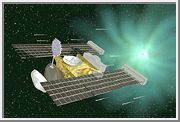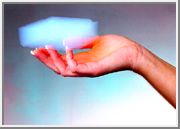
Courtesy of NASA's National Space Science Data Center
Table of Contents
- Description
- Spacecraft and Subsystems
- Sample Collection
- Mission Profile
- Comet P/Wild 2
- Stardust Home Page NASA/JPL
Launch Date/Time: 1999-02-07 at 21:04:15 UTC
On-orbit dry mass: 350 kg
Description
 |
| Stardust Comet Wild-2 Encounter [more information] |
The Stardust spacecraft consists of a box-shaped main bus 1.7 m across with a high gain dish antenna attached to one face of the bus. The total mass of the spacecraft including propellant is 385 kg. Two long rectangular solar arrays are connected by struts extending to the opposite sides of the spacecraft and with their surfaces in the same plane as this face, extending parallel to each other in their long directions. The short cone-shaped sample reentry capsule is attached at its narrow end to the front face of the bus. A paddle shaped sample collection disc can be extended from the capsule during periods of sampling, and stored inside the capsule enclosed by a cover when not in use. The propulsion units are on the rear face of the craft. A dust shield protects the main core bus and is equipped with dust flux monitors, vibro-acoustic sensors which will be able to detect particle impacts on the shield. The spacecraft is also equipped with another communication antenna, an optical navigation camera, and a dust spectrometer/particle impact analyzer. There are no scan platforms, all science instruments are body-mounted. Propulsion is provided by a monopropellant hydrazine system. Power is supplied to the craft by the silicon solar arrays.
 |
| Particle trails in aerogel. [more information] |
 |
| Aerogel in Hand. [more information] |
After a one day delay Stardust was launched on 7 February at 21:04:15.238 (4:04 p.m. EST). The launch took place from Pad A, Launch Complex 17 at Cape Canaveral Air Station aboard a Delta 7426 (a Delta II Lite launch vehicle with four strap-on solid-rocket boosters and a Star 37FM third stage). The four boosters fell away one minute and 6 seconds after liftoff (1:06 MET, mission elapsed time), the first stage shut down and was ejected at 4:30 MET. The second stage ignited a few seconds later, burned until 9:55 MET, followed by an ~11 minute coast and a reignition of the 2nd stage for 2 minutes. The 2nd stage separated at 24:27 MET and at 25:04 MET the 3rd stage ignited and burned for about 2 minutes. Stardust separated from the 3rd stage at 27:19 MET and opened its solar arrays 4 minutes later. The spacecraft is now coasting in an elliptical heliocentric orbit.
The first interstellar dust collection took place from 22 February to 1 May 2000. After one solar orbit, an Earth flyby was used to boost the spacecraft orbit on 15 January 2001 and another period of interstellar dust collection will open from July to December 2002. A second orbit of the sun will be completed in mid-2003 and the comet P/Wild 2 encounter will take place on 2 January 2004. The fly-by will have a closest approach of approximately 150 km at a relative velocity of about 6.1 km/s and will take place 1.85 AU from the Sun and 2.6 AU from Earth. The sample collector will be deployed in late December 2003 and will be retracted, stowed, and sealed in the sample vault of the sample reentry capsule after the fly-by. Images of the comet nucleus will also be obtained, with predicted coverage of the entire sunlit side at a resolution of 30 m or better. On 15 January 2006 the capsule will separate from the main craft (with a stabilizing spin of 1.5 rpm) and return to Earth. A parachute will be deployed and the descending capsule will be recovered by a chase aircraft over the U.S. Air Force Test and Training Range in the Utah desert at roughly 3 a.m. local time.
Comet P/Wild 2 is a newcomer to the inner solar system and therefore represents a relatively 'fresh' comet which has not been overly heated and degassed by the Sun. Originally in an orbit between Jupiter and Uranus, its orbit was altered by a close pass by Jupiter on 10 September 1974. It now orbits between Mars and Jupiter. The comet is approximately 4 km across. Comets were formed at the same time as the solar system and are made up of primitive condensates and grains incorporated into them at this time. The samples from the coma are expected to provide insights into the composition and dynamics of the early solar system.The interstellar dust grains represent a flux of fresh material entering the solar system from the direction of the constellation Scorpio. These particles are smaller and will impact at a higher velocity than the cometary particles. The size distribution, velocity profile, and compositional make-up of these particles are important to the study of processes taking place outside our solar system.
The total mission cost of Stardust is approximately $199.6 million, of which roughly $150 million is the cost of development and construction of the spacecraft.